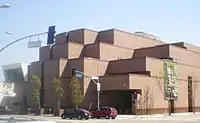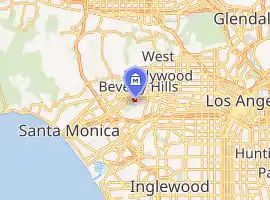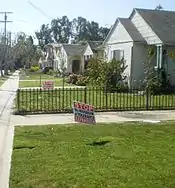Museum of Tolerance
The Museum of Tolerance-Beit HaShoah (MOT, House of the Holocaust), a multimedia museum in Los Angeles, California, United States, is designed to examine racism and prejudice around the world with a strong focus on the history of the Holocaust. The museum was established in 1993, as the educational arm of human rights organization, the Simon Wiesenthal Center.[1] MOT also deals with atrocities in Cambodia and Latin America,[2] along with issues like bullying and hate crimes.[3] The MOT has an associated museum and professional development multi-media training facility in New York City.
 | |

| |
| Established | 1993 |
|---|---|
| Location | 9786 W. Pico Blvd Los Angeles, California, United States |
| Type | Holocaust memorials, racism and prejudice museum |
| Visitors | 350,000 annually |
| Website | www |
The Museum is closed on Saturdays (Sabbath), the Jewish day of rest.[4]
Overview
The original museum in Los Angeles, California, opened in 1993. It was built at a cost of $50 million by the Simon Wiesenthal Center, named after its founder Simon Wiesenthal, a Holocaust survivor and Nazi hunter.[2] The museum receives 350,000 visitors annually, about a third of which are school-age children. The museum's most talked-about exhibit is "The Holocaust Section", where visitors are divided into groups to take their own place in some of the events of World War II. These experiences are then discussed afterwards. The museum also features testimonies of Holocaust survivors, often from live volunteers who tell their stories and answer questions. People also get cards with pictures of Jewish children on them and at the end of the museum trip, it is revealed whether the child on the card survived or was murdered in the Holocaust.

In addition, the museum features a "Tolerancenter" that discusses issues of prejudice in everyday life, a Multimedia Learning Center, Finding Our Families – Finding Ourselves, a collection of archives and documents, various temporary exhibits such as Los Angeles visual artist Bill Cormalis Jr's "A" Game In The B Leagues", which documents through paintings, the Civil Rights Movement during the segregation of colored people in Major League Baseball, and an Arts and Lectures Program.
A classroom visit to the museum is featured in the 2007 movie Freedom Writers, based on the real-life story of high school teacher Erin Gruwell and her students. The museum was parodied in an episode of South Park called "The Death Camp of Tolerance".
Over 350,000 people visit the Museum annually, including 110,000 children.[4]
Education
The Museum runs a program called The Museums Tools for Tolerance (r) for Law Enforcement and Criminal Justice Professional. Through its inception in 1996, it has trained over 75,000 law enforcement officers. The success of the program led to the creation of the New York Tolerance Center.[5]
Criticism
The museum has been criticized for providing a one-sided view of the Israeli-Palestinian conflict. Wendy Brown, describing the "Zionist political agenda of the Wiesenthal Center", wrote in 2009:[4]
The museum itself reflects these positions in its inclusion of American troops in Afghanistan as heroes of tolerance, its easy reference to pre-1948 Palestine as "the Jewish homeland," and its occluded mention of any other peoples living on that land then or now. For a time, one of its exhibits featured the widely disseminated footage of Palestinians falsely reputed to be gleefully celebrating the events of 9/11. At this writing, there are two brief representations of Palestinians in the whole of the MOT: a glimpse of the famous 1993 handshake on the White House lawn between Yitzhak Rabin and Yasir Arafat appears in the opening of one film, and a dubbed clip of angry Palestinian children crying out "We, the children, will go to kill them, murder them ... we won’t leave a single Jew" appears in another.
She also criticized the Museum for its cavalier attitude towards prejudice and genocide directed at non-Jewish groups:[4]
This position is reinforced by the MOT educational materials designed for high school students, in which "genocide" is identified as the correct word to match up with the statement "Nazis try to kill all the Jews," but "discrimination" or "racism" is the correct correlative to "Thousands of Native Americans are forced off their land." Thus, even as the name change and some of the newer exhibits of the MOT would seem to be part of a continuing attempt to widen and adapt its scope and appeal, other changes, such as the removal of the film on other genocides, ensure that the Holocaust is recentered, that this episode of "man's inhumanity to man" has no rival and no parallel.
But she also thought that the experience of the museum could make its visitors more vigilant against social prejudice and stereotyping:[4]
It may move some of its visitors, especially the more than 100,000 schoolchildren who visit every year, to be more internally—and perhaps externally—vigilant against social prejudice and stereotyping.4 It is possible that connecting contemporary instances of sexism, racism, homophobia, and religious and cultural prejudice with the Holocaust produces an understanding of the seriousness of all these issues, a recognition of their capacity to escalate to murderous, even mass murderous, proportions. And certainly many of the young people who visit are introduced to episodes of history—including, but not only, the Holocaust—that they had not previously known much about or regarded very seriously.
In 2003, the Museum was criticized for not featuring any exhibit about the Armenian genocide, despite Hier having promised that in 1985.[6]
Oren Baruch Stier, who specializes in Holocaust and Jewish studies, criticized the museum for not contextualizing the Holocaust. He argued against the museum's separation of its Tolerance and Holocaust sections:[7]
Therefore, although the connection between the Holocaust section and the Tolerance section of the museum is obviously encouraged, the distinction between them is still maintained to such an extent that the Holocaust is never contextualized - what remains is a hyphenated, double museum. But contextualization is, in fact, crucial....
In fact, the museum appears to want to have things both ways at once. At one moment it attempts to place the Holocaust in the context of a vaguely-determined "Judeo-Christian" ethic of "tolerance," and an indeterminate locus of social responsibility that has little real basis in tradition and/or culture and whose parental abstraction tends to erase the Jewish side of the marriage, while at the same time tries to maintain its separate unique status....
Here, tradition and memory are largely ignored, pushed to the sidelines in favor of a multi-media spectacle that ultimately fails to mediate much of anything.
See also
References
- "About us". Archived from the original on 2018-06-09. Retrieved 2010-08-23.
- "Los Angeles Journal; Near Riots' Ashes, a Museum Based on Tolerance". New York Times. February 10, 1993.
- "Teen court program tackles bullying, hate crimes". Los Angeles Times. July 22, 2012.
- Wendy Brown (10 January 2009). Regulating Aversion: Tolerance in the Age of Identity and Empire. Princeton University Press. pp. 108–113. ISBN 978-1-4008-2747-3.
- United States; United States. Congress. Commission on Security and Cooperation in Europe (2008). Tools for Combating Anti-semitism: Police Training and Holocaust Education, May 9, 2006 : Briefing of the Commission on Security and Cooperation in Europe. Commission on Security and Cooperation in Europe. pp. 56–. ISBN 978-0-16-081341-2.
- "Armenians seek place in museum: Wiesenthal center's lack of an exhibition on the 1915 genocide is criticized. Museum says a display is in the works" (PDF).
- Stier, Oren Baruch (1996). "Virtual Memories: Mediating the Holocaust at the Simon Wiesenthal Center's Beit Hashoah-Museum of Tolerance". Journal of the American Academy of Religion. 64 (4): 831–851. doi:10.1093/jaarel/LXIV.4.831. JSTOR 1465624.
External links
- Official website
- "Experiencing the Jewish Holocaust in Los Angeles: The Beit Hashoah – Museum of Tolerance", review essay by Harold Marcuse, Other Voices, v2.1, Feb. 2000.
- "Museum of Tolerance: The Story of a Hate Crime", TIME